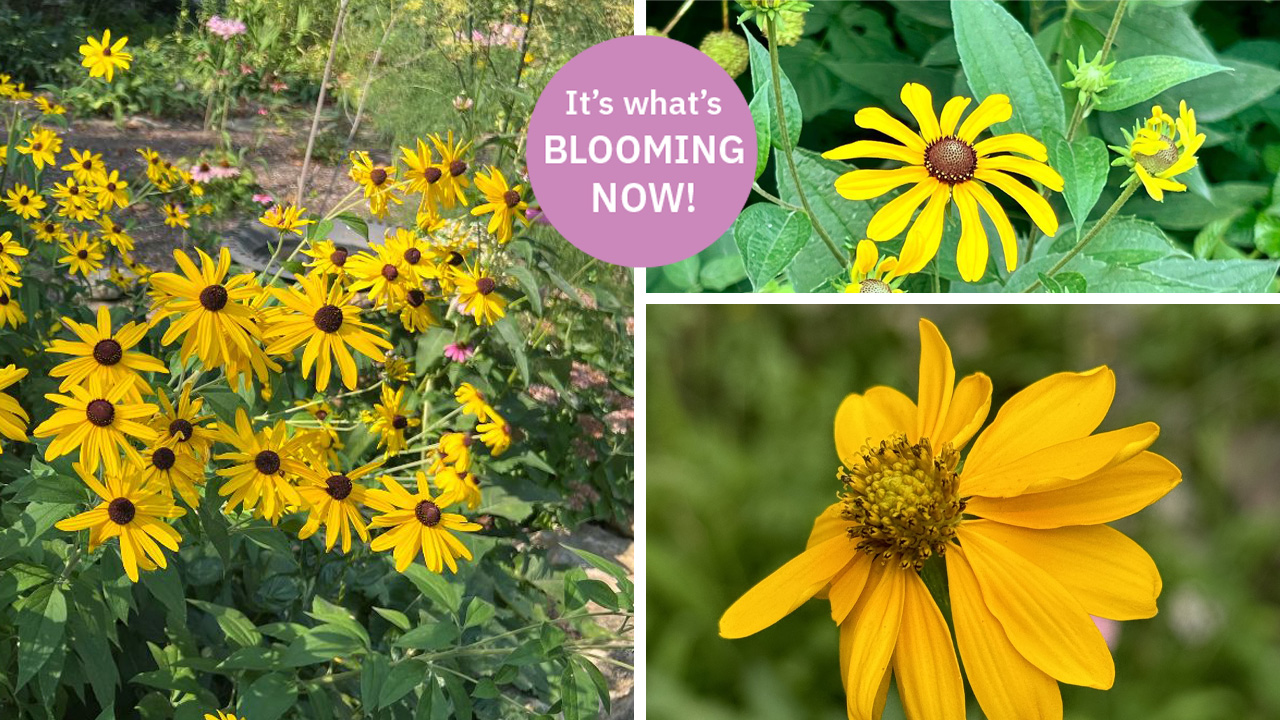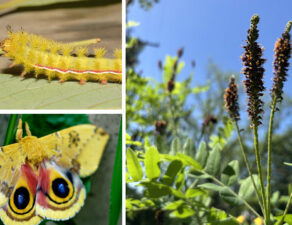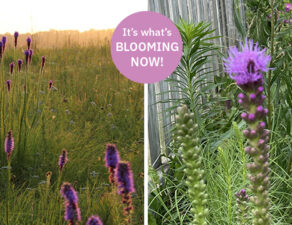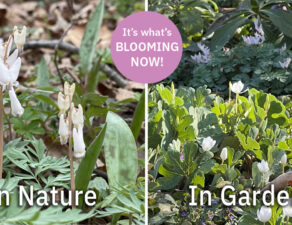
Rudbeckia Species
Sweet Coneflower (Rudbeckia subtomentosa) Black Eyed Susan (Rudbeckia hirta) and Wild Golden Glow (Rudbeckia laciniata)
In Gardens
Though rarely sold in conventional nurseries and often less familiar, Sweet Coneflower (Rudbeckia subtomentosa) is a good friend to gardeners.
Sweet Coneflower has upright habit and full, attractive foliage all season long –– no flopping and no brown withered leaves. The large blooms are plentiful from mid-summer to fall, and the leaves have a soft anise scent –– thus the name. Sweet Coneflower is also the longest-lived of Rudbeckias, lasting up to 20 years. And thanks to its fuzzy stems and thick, fuzzy leaves, it tends to be ignored by rabbits and deer –– reason enough to love it.
In nature Sweet Coneflower is found along stream banks and moist prairies, and understandably it is happiest in the usual perfect conditions: sunny and well-watered. But this species is extremely easy-going, adapting to a wide range of conditions, from rain gardens to dry driveway strips, and from full sun to a surprising amount of shade.
At maturity Sweet Coneflower can measure five feet tall and as wide across, with dozens of stems. This mass makes a great filler or background in the garden, or a shrub-like specimen in the landscape. If five feet is too tall, snip or pinch the stems by a third or half around Memorial Day, and they will bloom at three feet. If a plant gets too big across, split it at the crown, and pop the divisions in other parts of the yard. And if there happen to be more self-seeded plants than you can use, pass them along, and be a good friend to other gardeners.
In Nature
As nature enthusiasts you may hear acronyms like LBM (little brown mushroom) or LBB (little brown bird) which are tongue-in-cheek terms for species that are difficult to distinguish from one another. Mid to late summer marks the time for an abundance of DYCs (darn yellow composites!). This speaks directly to native flora like Helianthus, Silphium, and Rudbeckia in the Asteraceae family that cover the landscape. Though they can be tricky to ID, the more time you spend with them, the more likely you are to recognize and appreciate them.
You can tell a lot by the shape of a flower, like who pollinates it and what time of year it blooms. In spring we see lots of bell-shaped blooms pointing down for early emerging pollinators like queen bees and flies. In summer pollinators are attracted to upward facing composite flowers like Purple Coneflower (Echinacea purpurea) and Black-Eyed Susan (Rudbeckia hirta).
Composite flowers are made of many clustered “disc florets” surrounded by “ray flowers” or petals. Though each blossom or “inflorescence” looks like a single flower, they have lots of little areas to collect pollen and nectar. With this, these DYC’s offer great nectar and pollen sources for our pollinator friends.
Golden and cheery, Rudbeckia species are among our most valuable players in the ecosystem. They are considered a “keystone species,” as a disproportionately large number of other species rely on them. Not only do they provide pollen and nectar for over 50 bee species, their leaves host around 30 species of caterpillar between the Great Plains and Eastern Temperate Forest ecoregions.
From Missouri Coneflower (Rudbeckia missouriensis) to Wild Golden Glow (Rudbeckia laciniata), there are around 25 species of Rudbeckia in North America. Many of which can be found in both dry and mesic prairies or woodland edges across the Midwest.
GET TO KNOW SWEET CONEFLOWER:
Light Requirements: full sun to part shade
Soil Moisture: medium
Soil Description: tolerates dry and clay soil
Height: 3′ to 5′
Bloom Time: July – October
Bloom Color: yellow
GET TO KNOW BLACK EYED SUSAN:
Light Requirements: full sun
Soil Moisture: medium
Soil Description: tolerates dry and clay soil
Height: 2′ to 9′
Bloom Time: June – September
Bloom Color: yellow
GET TO KNOW WILD GOLDEN GLOW:
Light Requirements: full sun to part shade
Soil Moisture: medium
Soil Description: average, medium, well-drained soil
Height: 2′ to 9′
Bloom Time: July – September
Bloom Color: yellow





